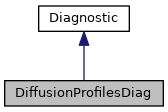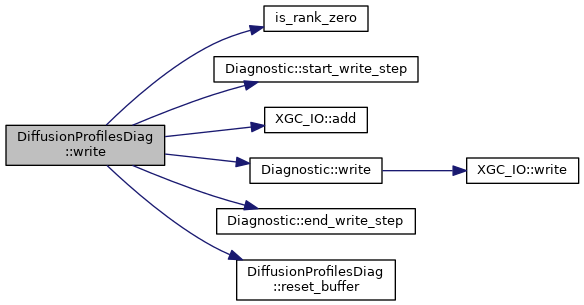Diagnostic for writing diffusion profile data using ADIOS2. More...
#include <diag_diffusion_profiles.hpp>


Public Member Functions | |
| DiffusionProfilesDiag () | |
| void | init (NLReader::NamelistReader &nlr, const Simulation< DeviceType > &sml, const Grid< DeviceType > &grid, const Plasma &plasma, int f_source_period) |
| Initialize the DiffusionProfilesDiag diagnostic. More... | |
| int | get_n_species () const |
| ** More... | |
| int | get_n_surf () const |
| Get the number of flux-surfaces sampled. More... | |
| int | get_n_samples () const |
| Get the number of samples taken. More... | |
| bool | is_triggered_output (int step) |
| Returns whether the buffer should be written out on this step. More... | |
| void | collect_sample (const Simulation< DeviceType > &sml, const Grid< DeviceType > &grid, Plasma &plasma, const Moments &f0_moments, const DomainDecomposition< DeviceType > &pol_decomp) |
| Collect a sample of diffusion profile data. More... | |
| void | write () |
| Write the buffered diffusion profile data to disk. More... | |
| void | reset_buffer () |
| Reset the profile data buffer. More... | |
 Public Member Functions inherited from Diagnostic Public Member Functions inherited from Diagnostic | |
| bool | is_triggered (int step) |
| bool | has_been_triggered (int step) |
| int | get_period () const |
| Diagnostic () | |
| void | init (const std::string &name, int period, int first_step=-1) |
| void | open_stream (const std::string &filename, const XGC_IO_Mode &mode) |
| void | close_stream () |
| void | write (const XGC_IO &xgc_io) |
| void | start_write_step () |
| bool | is_first_step () |
| void | end_write_step () |
Public Attributes | |
| bool | is_on |
| Flag to indicate if this diagnostic is active. More... | |
| View< double ***, CLayout, HostType > | profiles_buffer_n |
| View< double ***, CLayout, HostType > | profiles_buffer_u |
| View< double ***, CLayout, HostType > | profiles_buffer_T |
| View< double *, CLayout, HostType > | psi_grid |
| Poloidal flux grid of the sampled profile data. More... | |
| View< double *, CLayout, HostType > | time_buffer |
| Time (in s) of each sample. More... | |
| View< int *, CLayout, HostType > | step_buffer |
| Time step index of each sample. More... | |
 Public Attributes inherited from Diagnostic Public Attributes inherited from Diagnostic | |
| bool | is_on |
Private Attributes | |
| int | output_rate |
| Rate (time steps) at which the collected data is written out. More... | |
| int | sampling_rate |
| Rate (multiples of sml_f_source_period) at which the profile data is sampled. More... | |
| StepTrigger | step_trigger_output |
| Trigger for writing the diagnostic output. (The default trigger is used for the data sampling step.) More... | |
| int | n_species |
| int | n_surf |
| int | n_samples |
| int | sample_count |
Additional Inherited Members | |
 Protected Attributes inherited from Diagnostic Protected Attributes inherited from Diagnostic | |
| StepTrigger | step_trigger |
Detailed Description
Diagnostic for writing diffusion profile data using ADIOS2.
This diagnostic is controlled by a boolean switch (is_on) and an output interval. It collects and buffers the evolution of the flux-surface averaged plasma profiles—specifically density, parallel mean flow, and temperature profiles—along with the corresponding poloidal flux grid, time stamps, and simulation step indices. The diagnostic is defined in diagnostics.hpp and utilizes the diagnostic template interface.
Constructor & Destructor Documentation
◆ DiffusionProfilesDiag()
|
inline |
Member Function Documentation
◆ collect_sample()
| void DiffusionProfilesDiag::collect_sample | ( | const Simulation< DeviceType > & | sml, |
| const Grid< DeviceType > & | grid, | ||
| Plasma & | plasma, | ||
| const Moments & | f0_moments, | ||
| const DomainDecomposition< DeviceType > & | pol_decomp | ||
| ) |
Collect a sample of diffusion profile data.
This function gathers global moment data (density, parallel flow, and temperature) from the simulation. It first copies the host-resident moment data to temporary device views, then performs a toroidal average. The data is further averaged over flux-surfaces by mapping the simulation data from the 2D planar mesh representation to the required number of surfaces. Finally, the averaged data is copied into the host buffers.
- Parameters
-
sml Reference to the Simulation object. grid Reference to the Grid object. plasma Reference to the Plasma object. f0_moments Reference to the Moments object containing the f0 moment data. pol_decomp Reference to the DomainDecomposition object for the poloidal plane.


◆ get_n_samples()
|
inline |
Get the number of samples taken.
- Returns
- Number of samples.
◆ get_n_species()
|
inline |
**
Get the number of species being buffered.
- Returns
- Number of species.
◆ get_n_surf()
|
inline |
Get the number of flux-surfaces sampled.
- Returns
- Number of flux-surfaces.
◆ init()
| void DiffusionProfilesDiag::init | ( | NLReader::NamelistReader & | nlr, |
| const Simulation< DeviceType > & | sml, | ||
| const Grid< DeviceType > & | grid, | ||
| const Plasma & | plasma, | ||
| int | f_source_period | ||
| ) |
Initialize the DiffusionProfilesDiag diagnostic.
This function reads the necessary configuration options from the input namelists. The on/off switch and output rate are taken from the "diff_param" namelist, while the sampling rate is read from the "diag_param" namelist. It also performs a consistency check to ensure that the output rate is divisible by both the sampling rate and the base source period. In addition, the function allocates the buffers for the profile data and initializes the output trigger.
- Parameters
-
nlr Reference to the NamelistReader holding configuration options. sml Reference to the Simulation object. grid Reference to the Grid object. plasma Reference to the Plasma object. f_source_period The base period for sampling.
< Rate (multiples of sml_f_source_period) at which the profile data is sampled. (Must be compatible with diff_update_period!)


◆ is_triggered_output()
|
inline |
Returns whether the buffer should be written out on this step.
- Returns
- TRUE if buffer should be written, FALSE otherwise


◆ reset_buffer()
|
inline |
Reset the profile data buffer.
Resets the internal buffer for the profile data and the sample counter to zero.

◆ write()
| void DiffusionProfilesDiag::write | ( | ) |
Write the buffered diffusion profile data to disk.
This function is executed on the rank-zero process. It creates an XGC_IO object, adds the various buffered arrays (including the number of species, number of samples, flux-surface grid, time and step data, and the profile arrays for density, flow, and temperature) to the IO object, and then invokes the base diagnostic write routines. The output is wrapped between a start and end write step.


Member Data Documentation
◆ is_on
| bool DiffusionProfilesDiag::is_on |
Flag to indicate if this diagnostic is active.
◆ n_samples
|
private |
◆ n_species
|
private |
◆ n_surf
|
private |
◆ output_rate
|
private |
Rate (time steps) at which the collected data is written out.
◆ profiles_buffer_n
◆ profiles_buffer_T
◆ profiles_buffer_u
◆ psi_grid
Poloidal flux grid of the sampled profile data.
◆ sample_count
|
private |
◆ sampling_rate
|
private |
Rate (multiples of sml_f_source_period) at which the profile data is sampled.
◆ step_buffer
◆ step_trigger_output
|
private |
Trigger for writing the diagnostic output. (The default trigger is used for the data sampling step.)
◆ time_buffer
The documentation for this class was generated from the following files:
- /p/test_ssd/builds/t3_84szKM/0/xgc/XGC-Devel/XGC_core/cpp/diag_diffusion_profiles.hpp
- /p/test_ssd/builds/t3_84szKM/0/xgc/XGC-Devel/XGC_core/cpp/diag_diffusion_profiles.cpp